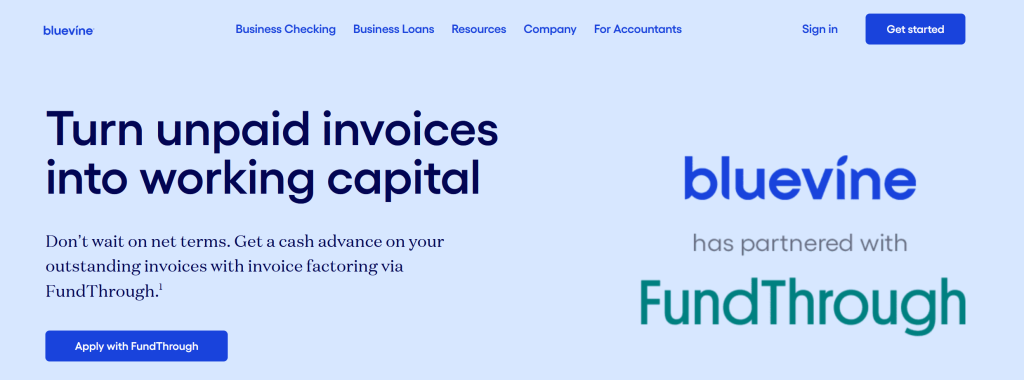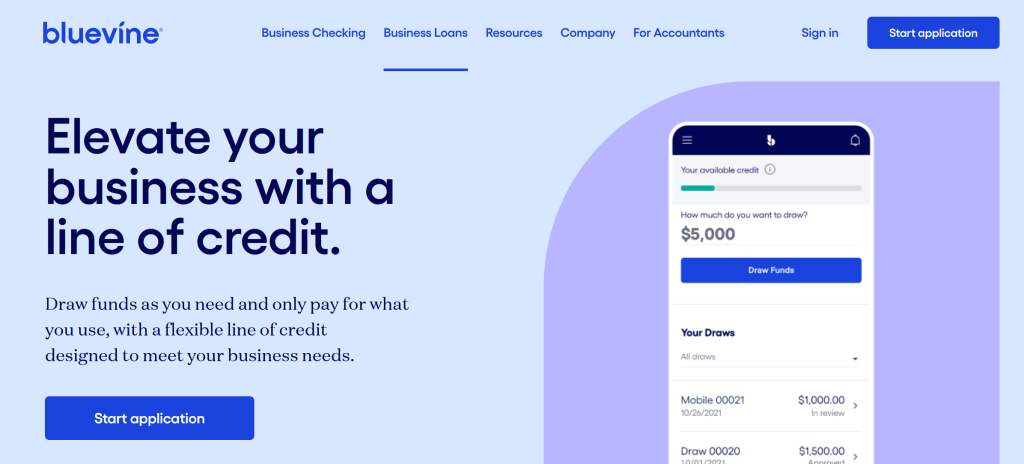BlueVine offers invoice factoring and lines of credit for improved cash flow while you’re waiting on payment from outstanding invoices.
We’ve previously discussed invoice financing, in which a company uses your business’s outstanding invoices as collateral to finance a loan. BlueVine takes this concept one step further by offering invoice factoring. The company partners with FundThrough to provide more capital and flexibility.
In this BlueVine review, we’ll look at what that entails and when it may be a good fit for you.
Note that there’s a slight difference between invoice financing and factoring, so be sure to understand these nuances before signing up with any company.
Invoice financing companies give you a loan based on the balance of your outstanding invoices. You then pay off the loan. If the invoice isn’t paid by the debtor, you’re still responsible for keeping up with payments.
With invoice factoring, you sell the debt to the third-party company for a percentage of the amount owed. The debtor then pays the invoice factoring company, who manages the invoices for a percentage of the amount due.
Although BlueVine states on its website it offers invoice factoring, it’s important to know the contract is a recourse factor. This means if the customer doesn’t pay the invoice, you’re responsible for paying it.
Let’s look at BlueVine and the financing options it offers.
Who Is BlueVine?
BlueVine is a Palo Alto-based financial technology company founded in 2013 by Eyal Lifshitz. It has so far raised over $49 million, and its major investors include Citigroup, Intuit, and Menlo Ventures. These powerful strategic partnerships enable integration with QuickBooks and referrals from Citi’s small business lending unit.
It has an A+ rating with the Better Business Bureau, although the customer reviews on the BBB site are negative. These reviews are centered on the fact that the company often evaluates accounts and lowers financing limits. All customer reviews discuss BlueVine’s business line of credit product, not the invoice factoring product.
What Financing Options Does BlueVine Offer?
There are two small business funding options: Invoice factoring and a line of credit.
Invoice Factoring
BlueVine’s invoice factoring provides loans from $20,000 to $5 million at an APR ranging from 15 percent to 68 percent, depending on your individual qualifications. Approval can take from a few minutes up to a full business day, and repayment plans are for one to 12 weeks, depending on the invoice due dates.

You’re paid 85 percent to 95 percent of the invoice amount and receive the funds within 24 hours of approval. The customer owing the invoice then pays BlueVine. If they fail to pay, you’re responsible for taking over payments, including a 3 percent late fee. There’s no origination fee, but there is a $15 fee for wire transfer payments. ACH payments are free, however.
To be approved for invoice factoring, you need have a B2B business operating for at least 3 months with $10,000 monthly revenues and a credit score of 530. With subprime credit scores, your client’s creditworthiness may be considered.
Invoice factoring is available in all states but can’t be used on past due invoices.
Line of Credit
BlueVine’s line of credit is a loan from $5,000 to $250,000 at an APR ranging from 15 percent to 78 percent. There’s an origination fee of 1.5 percent, and repayment terms are from 6 months to a year.

For a line of credit, you need a personal FICO credit score of at least 600 and a B2B business at least 6 months old with annual revenue of at least $120,000. BlueVine lines of credit are not available in Kansas, Nevada, North Dakota, South Dakota, Rhode Island, Tennessee, Vermont, or Virginia.
Regardless of which credit option is used, BlueVine places a UCC lien on the business. It’s important to pay on time or BlueVine can seize your business (and possibly personal) assets.
BlueVine doesn’t provide financing to B2C businesses or businesses in the adult or gambling industries.
How Does It Work?
BlueVine’s online application process is simple. You enter your name, phone number, physical address, email address, social security number, business tax ID, either a read-only connection to the business bank account or the last three bank statements.
It initially performs a soft credit check, although once you accept the loan, it will perform a hard pull. This is often what lowers the financing amount, which is the subject of the negative customer reviews on the BBB website. BlueVine reports to Equifax, Experian, and Dun & Bradstreet.
When using invoice financing, you choose which invoices to finance. Each individual invoice must be at least $500 with a due date between 1 and 12 weeks. Orders must already be fulfilled, and the business must be based in the U.S. or Canada.
Although BlueVine will fund the loan within 24 hours, your bank may hold the payment for longer, especially for larger deposits. Check your bank for individual release terms.
BlueVine Alternatives
Because BlueVine offers two unique business financing options, there are several competitors. Instead of listing the individual companies, I’ll discuss other ways to receive liquidity for your business.
Small Business Loans
The U.S. Small Business Administration has a small business loan program that lets you shop different lenders. These loans range from $500 to $5.5 million and can provide working capital at competitive interest rates. A small business loan is often the cheapest option for your business, although lending requirements can be strict.
In general, eligibility for small business loans depends on the type and size of business, revenue, available collateral, business plan, and both personal and business credit scores.
Investment Capital
Equity investments differ from business loans in several ways. Typically, you’ll give up a portion of business ownership, meaning the investors gain a level of legal control over the business operations and revenues. Equity investors are less interested in credit scores and focus more on future business profits. This makes Investment capital ideal for businesses with low creditworthiness but high profitability.
Investment capital only needs to be paid back if required in the contract terms. Typically, investors are buying a piece of the business and only receive a payout when selling their stake. If you sell off more than 50 percent, you lose control of your business, so keep this in mind. Each investor is different, and it’s important to fully read contract terms before signing.
Merchant Cash Advances
Merchant cash advances are offered by businesses like Square Capital and PayPal Working Capital. These cash advances work like more like payday loans instead of traditional loans. This means you’re charged a financing fee up front instead of an interest rate. If you were to calculate the interest rate on a merchant cash advance using the financing fee, it will typically be much higher than a business loan.
The advantage of merchant cash advances is approval is based on sales volume versus your credit rating. Repayments are also a percentage of sales, as opposed to a fixed monthly or weekly payment. It’s a great option for those who need liquidity but can’t get approved for a business loan.
Merchant cash advance companies typically place a UCC lien on the advance, so if you default, they can take your business and/or assets. Read the terms carefully before signing.
Invoice Financing
As discussed above, invoice financing is a loan based on outstanding invoices. These invoices act as collateral, and invoice volume matters more than creditworthiness. Invoice financing acts much like merchant cash advances, although the determination is based on sales already made but not paid for, as opposed to future sales.
Invoice financing typically charges an upfront fee and can have an origination fee. There is no interest rate, although if you calculate the fees as an APR, it’ll be in-line with cash advances. Repayment terms typically match the invoice due date and are for much shorter terms than business loans, often three months or less.
Non-recourse Invoice Factoring
With non-recourse invoice factoring, you sell the invoice amounts for an upfront amount that’s typically smaller than with recourse invoice factoring. The buyer then owns the debt, and you have no further obligations if the debtor defaults on the invoice. This type of loan used to be common but is very difficult to find nowadays.
If you have a large volume of unpaid invoices that are in default, you can typically sell them to a debt buyer or private debt collection agency. These organizations typically pay 10 to 20 percent of the invoice, so it’s only a viable option for seriously delinquent invoices.
Conclusion
BlueVine is a great option for businesses with low credit ratings to monetize unpaid invoices. While the fee is a bit high, it acts as an outsourced collections agency. If your business works with large companies that have better credit than you, BlueVine is the perfect way to gain short-term working capital and keep your business running.



